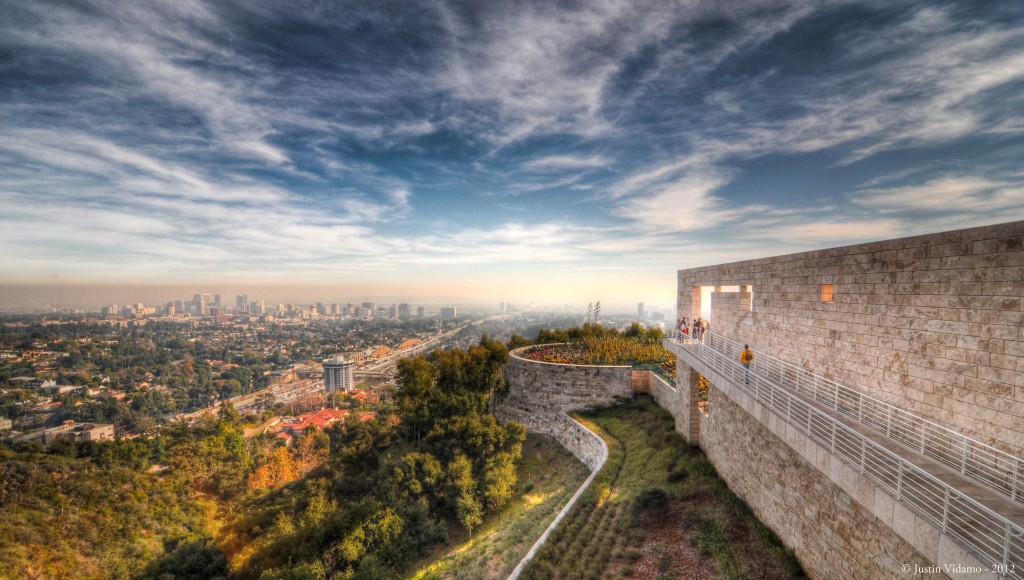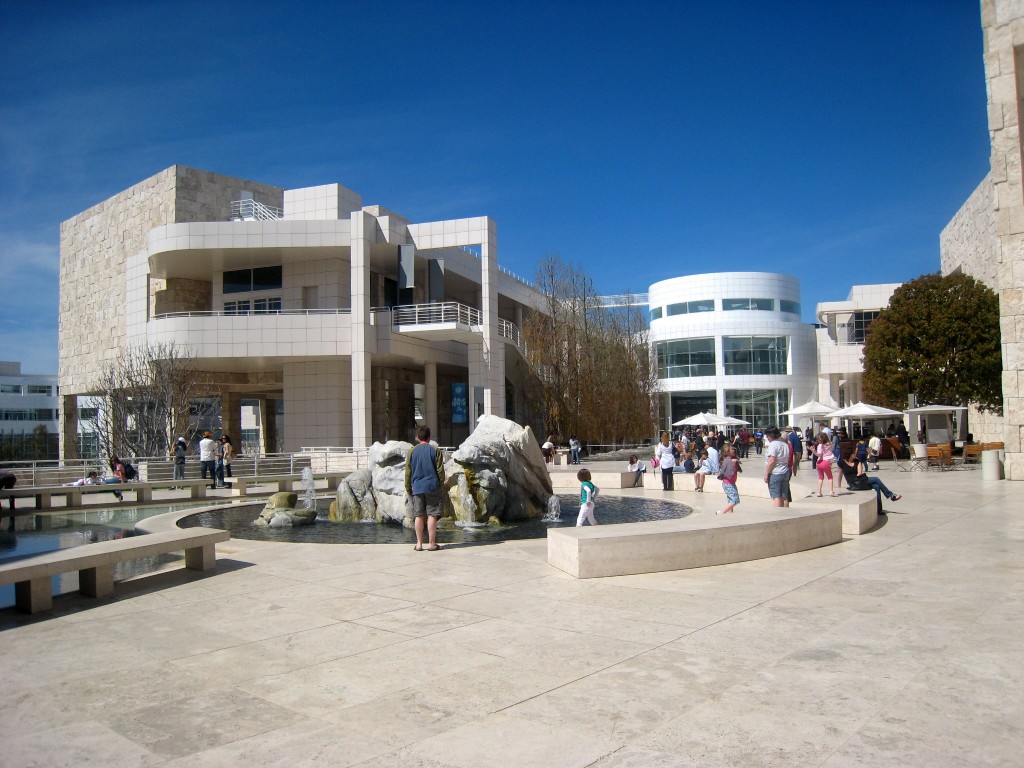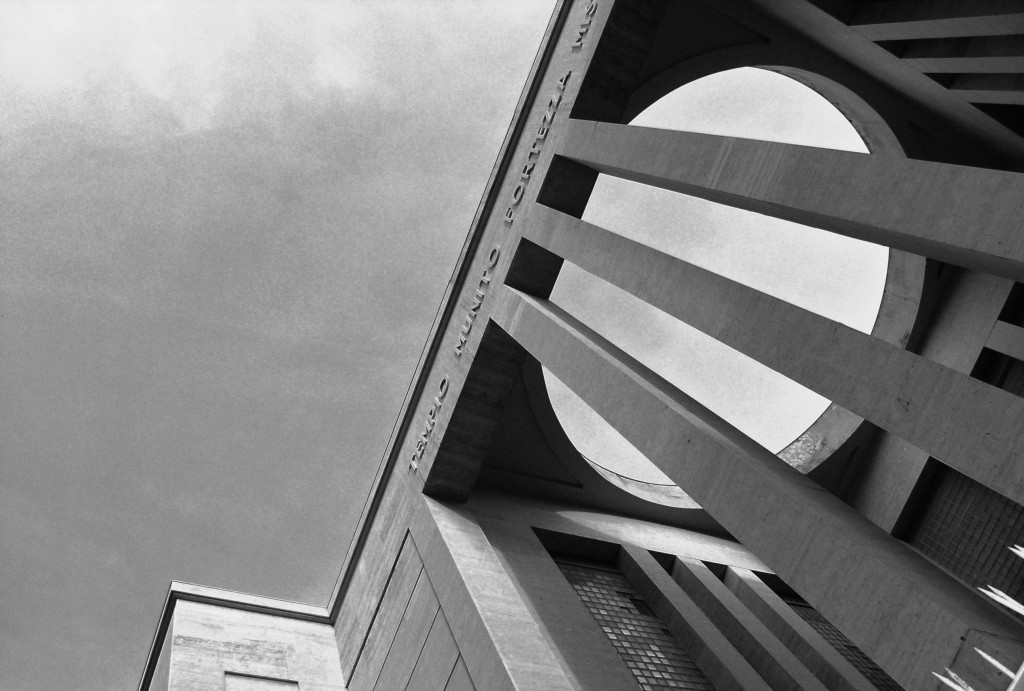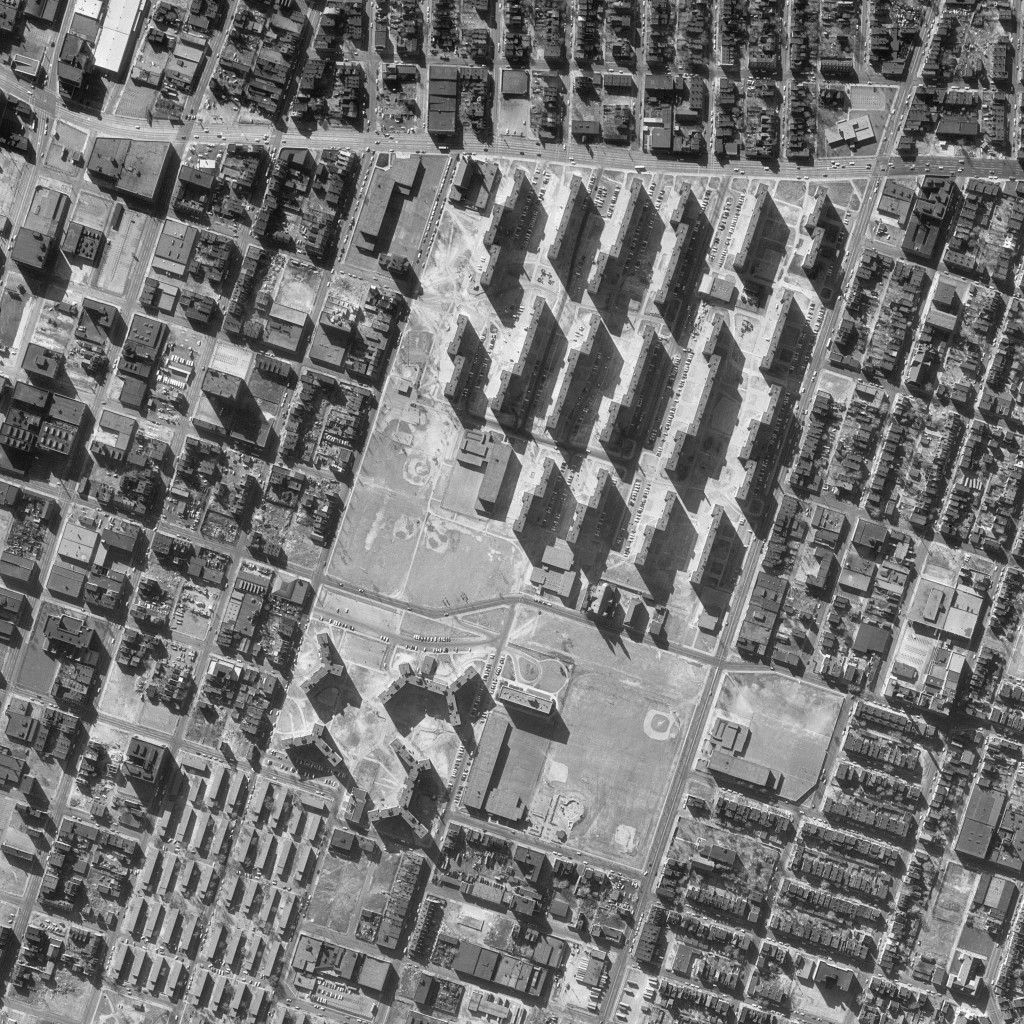By Rachel Stein
PART I: [Regarding the Nonsense of Spatial, Architectural, and Social Sense]
Los Angeles spills over itself until it collides with mountains, hard and defined to the ever-rolling waves to the West. Above it, the Getty stands tall and proud, posture straight and structure, firm. Built in 1997, a century after the rise of the Modern Movement, the building’s structure and content houses intentional friction that remembers an American history (Sveiven 2011).
This building, endowed with a staggering $6.6 billion held in the J. P. Getty Trust Fund, is one of the wealthiest art institutions in the world (Perman 2014). However, this wealth is independent of age, unlike other notable museums like the Philadelphia Art Museum and the Metropolitan Museum of Art. Although the Getty is younger than the majority of people reading this post, including myself, visitors can see some of the most internationally famous masterpieces here. Within the last two decade, the Getty has established its name as an important landmark of history and culture.
From within, its perfection enthralls visitors, who can be captivated for hours by the many masterpieces. But the art is not the only attraction. Its position provides breathtaking views. Beyond the personal experience of the hypothetical visitor without context, the Getty’s significance is more than surface deep. In one of the most expensive regions in one of the richest countries, a building must have monumental value. The Getty Museum denotes an architectural and social movement that has defined this nation and continues to shape the American experience; it is a monument to our past, present and future.
The museum itself is a piece of art, providing the visitor and viewer with a range of contentious physical and social elements that create a structure irresistible to the human gaze. Its façade clearly references modernism with clean-cut edges and minimal embellishments. Yet carefully planned landscaping that exist within and surrounding the building supply a sense of human scale that is often missing from many historically modernist complexes. Located on a mountaintop, the Getty is isolated from Los Angeles. This distance is further established by access to it: the museum provides a single parking garage carved into the mountain with a limited number of spaces located at the bottom of the mountain. An automated tram transports visitors from within the mountain to the museum sitting steady atop it—an epiphany-like experience, being brought out of darkness and into a museum of glowing white, light quality enhanced by the sprawling yet confined character of Los Angeles’s growth, a garden of Eden (Sveiven 2011).
The age and cultural significance of the artwork housed in the Getty, exhibiting the artwork of Rembrandt, Picasso, Van Gogh, to name a few, contrast the youth of the museum, architects, and city. And finally, the modernist architecture reminiscent of the recent past unrelated to its location yet this same architectural quality supply a place and symbol of education and value. By displaying historical art, the Getty compensates for the city’s lack of artistic relevance that has previously been missing from the cultural landscape of the Hollywood lifestyles of a city. It gives Los Angeles a responsibility in the context of historic preservation. Apart from the city context, the Getty brings a memory of a past with the hope for a (better informed) future, and highlights the important relationship between architecture and people, the built environment and understanding of social history, between evolution of society and the human experience (Anderson 1997).
While buildings, complexes and cities crumble under the pressure of critique that claim that such structures and deigns are both dehumanizing and unrelatable, a few still remain. Likely, the Getty will be one of these survivors. Surely, its grandeur and beauty make it a symbol.
“Giuseppe sparisano, casa del mutilato, Palermo, 1935-1938” by seier+seier | flickr
PART II. What One Building Says About a Nation
Urban planning and city design act as lenses for analyzing the relationships between the physical and social nature of cities and societies. Specifically, the Modern Movement intertwined with advancing technology and changing worldviews, produced a movement in architecture and urban planning. The Modern Movement has changed the landscape of American cities, and in effect, the American experience. It has produced countless counter-movements, and by suggesting a novel way of organizing people and objects, it has inspired thinking about these relationships in a new context. Entire cities as well as individual blocks evidence this (Wirka 1996). Even a single building—the Getty—tells the story of the transformation of design, of planning, and of social patterns.
Urban planning and its many forms bring with it a myriad of opinions, power and influences. History tells of how planning can take active roles in community development, such as gorilla urbanism and smart growth initiatives. It can be an influencer for bettering the human experience, and it can be one that destroys the good that cities have to offer. While attention to architecture has been a part of many cultures dating back to the Chinese dynasties and Ancient Greek and Roman empires, the profession of urban planning is much newer. In fact, the first instances of urban planning as we think of it today emerged at the beginning of the twentieth century, hardly over a century ago. It emerged alongside the rise of modernism and the idea that practicality and efficiency of architecture, as seen in the exposed steel frames of skyscrapers and barren facades of enormous structures, would promote human well being. However, modernist architecture infamously leaves buildings completely out of scale to the user, and in so doing, takes away from its value as good design. Simplistic yet dominant buildings were accompanied by the re-emergence of gridded streets support efficient transportation of goods, and circulation of commerce dictated by purpose-driven planners. And in order to make such physical structures and street organization effective, planners required policy in order to confirm and support the implementation of these new ideals (Scott 1998). Thus, zoning policies provided the political counterpart to the physical architecture. While in theory the driving ideals of modernism and the simplification of the value of the city as a system of the exchange of material goods seemed flawless, human nature ingrained assumptions and prejudices into implementation. After decades of modernism—successes and failures—the movement began to be defined by the problems that it produced rather than those it solved (Scott 1998). Redlining, social rights to the city, the importance of the “messiness” of the city, planning as a position of advocacy rather than dictator––these are just a few of the reactions to modernism, reactions that continue to develop even to this day (Davidoff 1965).
“Pruitt-Igoe” |Wikipedia
https://upload.wikimedia.org/wikipedia/commons/0/09/Pruitt-Igoe_1968March03.jpg
Yet Modernism is one of the best-known movements of urban planning and architecture. Incomprehensible art, and bleak or ugly architecture have surfaced as key symbols of the movement, and cemented a reputation as unattractive and undesirable (Lara 2009) . The momentum of this movement deteriorated after recurring failures and tragedies of massive developments and projects in the 1950’s. The demolition of Pruitt-Igoe has famously been said to symbolize the death of the movement.
“Pruitt-Igoe Collapses” | Wikipedia
https://upload.wikimedia.org/wikipedia/commons/1/1b/Pruitt-Igoe-collapses.jpg
So why, decades later, would an architect choose to incorporate many design themes of this “disastrous” movement into this strange space that makes little intuitive spatial, architectural, or social sense. Why would something that seemingly failed so miserable be something to be mimicked? The value of the architectural advancements that occurred during the years of the modernist movement was significant. The revolutionary theories and practices of urban design occurred as a reaction to the building contention of city and people. Before the 1900’s, cities tended to be places in which people crowded together, diseases spread quickly, people lived in dangerous or unpleasant living conditions with hazardous industry happening adjacent to residential buildings. The life of the city dweller was far from desirable. Then came along significant advancements in technology, which spurred an entire architectural and art movement. Exposed steel-framed buildings popped up all over cities, while zoning ordinances affected segregation of business, residence, and industry. After World War II, the economic boom and technological advancement changed the lifestyles for the Americans. The car, the refrigerator, the TV, and many other amenities made life easier in many ways. But all of this progress came with a shadow of social-rights issues.
Throughout the twentieth century, architectural and urban planning related movements swept America in reaction to the built environment and developing social issues. Redlining and racial discrimination became institutionalized via politics and political machines.
The City Beautiful movement swept through major cities such as Philadelphia and Chicago. This movement has largely been credited with institutionalizing the profession of urban planning. Governments now looked to urban planners with visions of enhancing the aesthetics of the city, in hopes that outward elegance would cause a transformation of the contents within (Wirka 1996). In reaction the focus on the purely physical renewal, the City Practical and the City Social movement further refined the objectives of the planner, expanding the realms of city planning. Women and marginalized groups demanded a say in this new business of urban planning, expressing their needs through events of the City Social Movement, which focused on the social and economic character and development of cities, and the City Practical which focused on project that were efficient and practical solutions to city problems rather than focusing on what is pleasing to the eye. The three of these movements set a tone for the coming centuries for the profession of urban planning in America as well as an American mindset and experience (Wirka 1996).
Modernism begins to get involved within this back-and-forth between city and people, built and natural during this same period. While modernism specifically refers to the architectural nature of city planning, it cannot be separated from its users. Scott notices this when he writes of “high modernism” in grave terms, saying that its tragedy is due to the hubris of those implementing modernist plans that expand beyond the realm of a single building and into societal structure, and the inability of people to protest such organization and control (Scott 1998). The radical ideologies brought about by the Modern Movement contrasted the way society had previously been thought of, as it provided scientific answer to what were once seen as natural processes. This impacted street design, building design, as seen in the expressionless buildings that somehow terrified viewers, and more importantly, the way that people interacted, the way that families functioned—it changed how people experienced life.
Again, it is important to remember that such changes did not destroy a culture, taking without also giving back. Modern buildings provided homes for the homeless, awareness of public health and a motivation to begin to provide alternatives to the terrible conditions of the urban environment. It provided the means to support a population on the rise. Memories of life before the industrial age have largely faded, and this generation forgets the life styles of those who came before us. Modernism’s impact on establishing the profession of urban planning has forever changed the American landscape, spurring tangential and contrasting movements, leaving no resident untouched.
Part III: Conclusion: What One Building Says About a Nation
The Getty Museum is a product of innovation and history and as such has a story to tell—further, history is all around us and is constantly developing, and a single building can encapsulate this history that is important to remember and consider for the future, whether or not that history is something we are proud of. And finally, the built environment has significant implications for the people it is built for, and as such it ought to be treated with consideration and with an open mind that is willing to take responsibility for its actions as well as work to alter its creation in a way that is beneficial to humankind. Within this relationship of people and place, the urban planner has the responsibility to understand the past and present, and prepare for the future. The job of the planner, whether it be as a position of advocacy or a position of policy making, or whatever shape that job may take, is to serve people and planet.
Works Cited
Anderson, Kurt. “A City on a Hill.” Kurt Andersen Journalism. The New Yorker Magazine, 27 Sept. 1997. Web. 15 Nov. 2015. <http://www.kurtandersen.com/journalism/the-new-yorker/the-getty-museum/>.
Davidoff, Paul. “Advocacy and Pluralism in Planning,” Journal of the American Institute of Planners, 31 ( 4) (1965), pp. 544–55. Reprinted by permission of Taylor & Francis Informa UK Ltd.
Lara, Fernando Luiz. “Modernism Made Vernacular: The Brazilian Case.” Journal Of Architectural Education 63.1 (2009): 41-50. Academic Search Premier. Web. 1 Dec. 2015.
Perman, Stacy. “Behind the Scenes at the Getty.” Financial Investment News. Barron’s, 27 Sept. 2014. Web. 20 Nov. 2015. <http://www.barrons.com/articles/SB52784017629588234037504580174223702644424>.
Scott, James C. “Authoritarian High Modernism”; from Seeing Like a State: How Certain Schemes to Improve the Human Condition Have Failed, pp. 87-102, 376-81, Yale University Press, 1998.
Sveiven, Megan. “AD Classics: Getty Center / Richard Meier & Partners, Architects LLP” 15 Jan 2011.ArchDaily. Accessed 1 Dec 2015. <http://www.archdaily.com/103964/ad-classics-getty-center-richard-meier-partners-architects/>
Wirka, S. M. (1996). “The City Social Movement: Progressive Women Reformers and Early Social Planning.” Planning the Twentieth Century American city. M. C. Sies and C. Silver. Baltimore, M.D., Johns Hopkins University Press: 55‐75.






